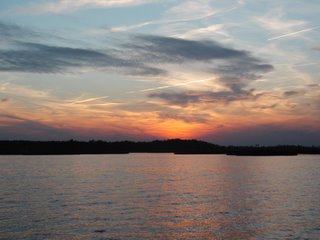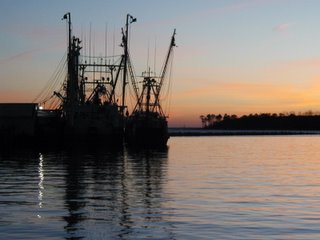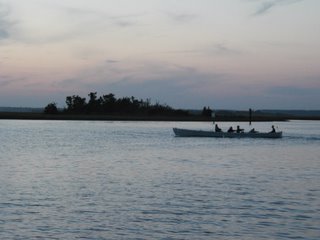Norfolk is another of those harbours which keeps the sailboat crew on their toes. There is a wide variety of traffic, smaller and larger, including large cargo ships, tugs and barges, large commercial fishing boats, passenger ships and warships. We had to maintain our distance from navy facilities and keep our eyes peeled for everything else. Commercial traffic continues until the second opening bridge on the system - while we were waiting for it to open we watched two tugs which had been bringing a large cargo ship through the twists and turns behind us move it sideways into its berth. Watching those tugboats work left us very impressed with the seamanship of captains and crew.
Once past the second bridge, we were on our way to then through a small lock, and into the Dismal Swamp Canal. The name sounds as if it should be a place of ghosts, goblins and witches. If there are any ghosts, they are the ghosts of history, since this canal was surveyed by George Washington and dug by slaves. It is beautiful, but its continued existence as a route for pleasure boaters is up in the air and the funding needed to keep it open is in question year after year. And yet it is a place of beauty and history that Americans are justly proud of, and one which leaves the boater with a very different view of the United States that any you may get passing through more quickly.
We spent a night at a small dock on the canal which we reached as darkness was falling; we rafted there with another sailboat we had gone through the lock with. But first we had to wait while a farmer who has special permission to run a bridge across the canal got trucks, equipment and workers across to the other side - one of those very long five minutes. The next day we stopped briefly at the Visitors Centre, where the staff were very friendly and helpful. We got free guides and were able to exchange books, dump trash and get water before heading for the lock out of the canal, passing a barge clearing the canal along the way. The bottom of the canal becomes the resting place of bits of trees from the banks, which sometimes fall into it as the banks erode.
After the Dismal Swamp comes one of those destinations cruisers aim for - Elizabeth City. The dock is free for forty-eight hours and there are volunteers there to greet you and help you dock when you arrive, and make sure you can find your way around town and get what you need. If there are enough new boats that day, the Rose Buddies hold a wine and cheese, very simple, in the afternoon and make everyone welcome, and cruisers get to meet each other and sometimes see old friends again. Like Waterford on the Erie Canal, it adds just that little extra bit of friendliness and warmth that encourages people to stay and come again.
We took advantage of good winds to go across Albemarle Sound, and enjoyed the opportunity to sail instead of motoring. It was a good day, followed by a decision to stay the night in Alligator River Marina rather than feel our way into an unmarked anchorage or anchor in the Alligator River. We thoroughly enjoyed it there - small but clean and friendly and providing everything we needed, including hot showers and a place to buy breakfast, just for a change, the next morning. When we came in there was a Jimmy Buffett tape playing on the speaker system, just loud enough so that we could listen to it if we wanted to...
Of course the next day, after going through the Alligator River, we did feel our way into an anchorage on Bear Creek - some of the shoals were marked with stakes, and there were some crab pots which helped show where some of the deeper water was. We stayed two nights, having decided to sit out a blow in the shelter there rather than head for Oriental and be there for the Veterans Day Holiday - we needed to buy some more charts and a few other things, and wanted to be sure we had a good shopping day, since free docking is limited to 48 hours.
Oriental proved to be a great place to visit. We managed to find a place at the free dock, which only has space for three boats. Down the road was a marine store, and across from the dock a cafe with some of the best cinnamon buns we have had. A lot of people come down to the dock to see who is there, and visit and chat. Many of them are ex-cruisers or between-cruisers, who had stories and advice to offer. We did more work on the boat, were given a drive to the grocery store and a short tour of the town by one kind gentleman, and spent time being visited. Oriental is one of those towns which is genuinely welcoming and friendly. We even got help with our wi-fi.
From Oriental we followed the ICW to Beaufort, North Carolina, where we ran into Kim and David again when we were briefly anchored in the same creek. They moved on to where the action was, while we stayed put in the back door anchorage. It was interesting - the dinghy dock dried out at low tide, but a friendly gentleman offered to let us tie up to his houseboat while we went and did laundry. We chatted, of course, and when we came back he had a suggestion for the next part of our journey - to go outside to Masonboro outlet, before Cape Fear, go inside to Cape Fear, and then head back out again. And that is what we did - it worked very well, since conditions outside were not going to be good for very long.
We left early in the afternoon to sail overnight to Masonboro Inlet, to be sure we would get there in daylight. The night proved exciting, as we went from light air to a double reef in the main, back to full sails, and then back to a double reef with partially furled jib, before heaving to to ride out a storm before dawn. Tiredness probably was a large part of the reason we ran aground the next day, and had some practice laying out our anchors and waiting for the tide to rise. By the time we made it to the anchorage we had chosen at Columbia Beach, it was dark - so we had to feel our way cautiously in and bumped on a sand shoal before we were able to get anchored safely. After that, we slept...
We waited at Columbia Beach for good weather to make the next trip outside, and when we finally heard a good forecast set out early in the morning for a trip down to Charleston. We had hoped to make St. Mary’s River, the border between Georgia and Florida, but the weather window was not long enough. As we entered the Cape Fear River we put the jib up; we never did put the main up, because with the wind behind us and on jib alone we were flying along at hull speed and higher; at times we were surfing down the waves. And at the same time our wind generator was keeping the batteries charged, meaning that there was probably about 25 knots of wind instead of the forecast 10 to 15 knots. It stayed the same all through that day and the night that followed, and we got to the channel in Charleston before daybreak the next day. By 9:23 the next morning we were anchored in a creek close to Charleston, having covered about one hundred and seventy miles in about twenty-seven hours. Not bad for our boat, but somewhat exhausting for us ! Once again, we slept.
Windy weather on its way meant a change of anchorage to one with better holding and more shelter from the waves, and we spent a couple of days anchored behind a marsh island on the Stono River waiting for the 35 to 40 knot gusts to subside. Good anchors are a wonderful thing. Then we spent the next few days travelling inland down the ICW to Beaufort, South Carolina. At Beaufort we anchored up Factory Creek where we stayed for a couple of days while visiting Beaufort, a town of graceful buildings with a thriving downtown shopping district along the waterfront. We used the visit to look after those necessities of cruising life, laundry, shopping and showers, before we headed out the Beaufort River inlet to Fernandina Beach, Florida.
Heading out, we put up the sails as we were going out the inlet. The winds were brisk when we started, and at first we were travelling under reefed main and partly furled jib and surfing along until the winds died down toward the next morning. We ended up motorsailing for a couple of hours to reach the inlet. Then it was in along the white sand beach, and anchor up yet another river across from the town and harbour, to spend another couple of days waiting for the winds to shift around to out of the north and exploring the town by foot, enjoying the colorful buildings, big old trees and rows of palms.
From Fernandina Beach we set out on a projected three day sail to Miami. With the winds behind us, we made very good time and were outside the inlet to the Port of Miami in less than three days. Rather than go in in the darkness, we spent several hours lying hove to while waiting for daylight, and watching the cruise, cargo and container ships anchored off the port waiting for pilots. The cruise ships are always easy to see, since they are lit up like Christmas trees. Since the pilots start work before daylight, by the time we were ready to go in we did not have to worry about the parade of big ship traffic. Once inside we headed for a marina where Into The Blue will spend the next few weeks while we visit with some of our family, and do yet more boat work. With the experience that comes from actually doing this, we have found there are some changes we need to make, and of course there is always maintenance...
Written Dec 7, 2005
 Looking down the Dismal Swamp Canal, quiet and peaceful and surrounded by trees. Its depth is uncertain and speed limit restricted, so it is used mainly by sailboats with shallower draughts and trawlers.
Looking down the Dismal Swamp Canal, quiet and peaceful and surrounded by trees. Its depth is uncertain and speed limit restricted, so it is used mainly by sailboats with shallower draughts and trawlers. Another view of some of the trees surrounding the Dismal Swamp Canal. There are birds of several kinds, including woodpeckers - we saw evidence of their work many times, but only heard one once.
Another view of some of the trees surrounding the Dismal Swamp Canal. There are birds of several kinds, including woodpeckers - we saw evidence of their work many times, but only heard one once. Elizabeth City is a key destination for cruisers coming through the Dismal Swamp route of the ICW. Friendly volunteers make everyone welcome, and the city is hospitable to everyone - though its businesses do close down on Sundays.
Elizabeth City is a key destination for cruisers coming through the Dismal Swamp route of the ICW. Friendly volunteers make everyone welcome, and the city is hospitable to everyone - though its businesses do close down on Sundays. The downtown streets of Elizabeth City are undergoing a renaissance, with many small stores moving in.
The downtown streets of Elizabeth City are undergoing a renaissance, with many small stores moving in. Alligator River Marina was an unexpected find, inexpensive, with good facilities and a simple, clean layout. All this, and a morning paper too!
Alligator River Marina was an unexpected find, inexpensive, with good facilities and a simple, clean layout. All this, and a morning paper too! You go carefully along Alligator River, minding the chart and staying in the channel - and even then there is no guarantee that you will not meet deadheads (floating logs). There are many dead trees along the banks as well.
You go carefully along Alligator River, minding the chart and staying in the channel - and even then there is no guarantee that you will not meet deadheads (floating logs). There are many dead trees along the banks as well. We anchored for two nights in Bear Creek, with a windy day in between. We had to feel our way in between shoals, some marked with stakes, but it is very sheltered from most wind directions - good for peace of mind.
We anchored for two nights in Bear Creek, with a windy day in between. We had to feel our way in between shoals, some marked with stakes, but it is very sheltered from most wind directions - good for peace of mind. Shrimp fishing boats sitting in the harbour in Oriental, North Carolina. They trawl with nets lowered from the long booms, now raised.
Shrimp fishing boats sitting in the harbour in Oriental, North Carolina. They trawl with nets lowered from the long booms, now raised. A sport fisherman, passing us full blast - something we have not met very often in this part of the waterway. Most people are considerate, and pass slowly making as little wake as they can.
A sport fisherman, passing us full blast - something we have not met very often in this part of the waterway. Most people are considerate, and pass slowly making as little wake as they can. As we approached Beaufort, North Carolina along the Adams Creek Canal we could see the sand banks along one side of the river, and felt how much closer we were getting to the sea again.
As we approached Beaufort, North Carolina along the Adams Creek Canal we could see the sand banks along one side of the river, and felt how much closer we were getting to the sea again. One evening in Beaufort NC we saw this team go out rowing. Note that everyone seems to be doing their own thing...
One evening in Beaufort NC we saw this team go out rowing. Note that everyone seems to be doing their own thing... We were in Beaufort, North Carolina when we saw this boat for the second time - the first time was Jackson Creek on the Chesapeake. This meant that this was one of the few times we were not the smallest boat in the harbour. A young couple are cruising in this boat, heading for ??? They did not know for sure.
We were in Beaufort, North Carolina when we saw this boat for the second time - the first time was Jackson Creek on the Chesapeake. This meant that this was one of the few times we were not the smallest boat in the harbour. A young couple are cruising in this boat, heading for ??? They did not know for sure. This anchorage on the South Edisto River in South Carolina was the most isolated one we have been in so far - when night fell, there were no lights around, and the only traffic we saw were hunters heading for their blinds.
This anchorage on the South Edisto River in South Carolina was the most isolated one we have been in so far - when night fell, there were no lights around, and the only traffic we saw were hunters heading for their blinds.
 One day we saw shrimp boats out trawling around where we were anchored up the Bell River across from Fernandina Beach. The birds were following closely - pelicans and gulls - looking for their share.
One day we saw shrimp boats out trawling around where we were anchored up the Bell River across from Fernandina Beach. The birds were following closely - pelicans and gulls - looking for their share. Here the shrimp boat is listing to the side as it brings in its net and catch. The birds are hovering...
Here the shrimp boat is listing to the side as it brings in its net and catch. The birds are hovering... One of the main streets in Fernandina Beach, with Christmas decorations already in place. Palm trees helped create the feeling of being in a tropical place. There was a big Christmas tree down by the harbour, decorated with festive red ribbons.
One of the main streets in Fernandina Beach, with Christmas decorations already in place. Palm trees helped create the feeling of being in a tropical place. There was a big Christmas tree down by the harbour, decorated with festive red ribbons.